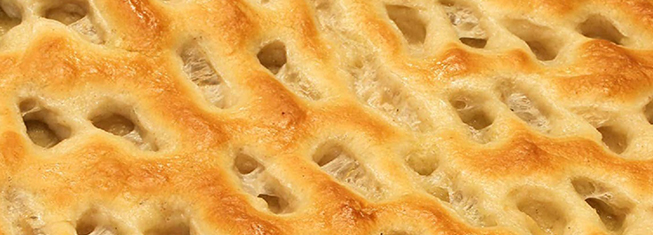Genovese Focaccia: Its Origins and Recipe

«Fugassa, fugassa,
drento a-o papê de strassa
mangiâ de bon mattin!
Mangiäte in sce-a terassa
e beivine un gottin…
a l’è ancon ‘na demöa
che a-i vegi a ghe fa göa
e i zoeni a mette in trappa
ciù che un gottin de rappa!»
– Costanzo Carbone
(A poem in the Genoese dialect)
Warm, fragrant, and appetizing, there aren’t enough adjectives to describe this delicacy that can accompany your day from morning to late-night snack.
In fact, there’s English breakfast, Continental breakfast, Italian breakfast, and Genoese breakfast: coffee, cappuccino, and focaccia. If you cut it into cubes, it’s perfect for an aperitif, especially when paired with a nice glass of white wine “u gianchetto,” just as the Ligurian tradition teaches.
Unthinkable for a Ligurian not to love our low, well-oiled, warm focaccia fresh out of the oven. An unconditional and uncontaminated love, finding its reason in the simplicity of ingredients: flour, water, yeast, extra virgin olive oil Riviera Ligure DOP, salt – simple elements giving rise to a genuine dish, as straightforward as the character of the Ligurians and Liguria.
But where exactly did this delicacy originate? Well, its origins are lost in the mists of time: economical and substantial, it was already a tradition in Genoa in the Middle Ages, even consumed in church, especially during the blessing of couples as a wish for prosperity.
The classic focaccia in Liguria is the Genovese focaccia, the simplest and for many, the most delicious: soft but never rubbery inside, pleasantly crispy and golden on the edges and surface, characterised by the presence of typical alveoli, obtained by “pricking” the dough with fingertips to collect the oil.
The classic focaccia is enriched with various ingredients making it even better: thinly sliced potatoes arranged on the surface, or thinly sliced onions sprinkled on the dough before baking, with tasty rosemary, sage, or pitted olives.
The Trademark
To protect the traditional focaccia from counterfeiting or clumsy attempts at imitation, the Collective Trademark “Focaccia Genovese” was created in 1996, bringing together bakers who prepare it with flour, extra virgin olive oil, yeast, sea salt, water, malt extract, and nothing else!
The Recipe
Its secret lies in choosing excellent ingredients and long leavening. It’s said that the success of the “fügassa” also depends on the baker’s sensitivity in reconciling the climate and external temperature with the leavening processes.
For the dough:
- 1kg reinforced 00 flour
- 0.550 kg water
- 50g extra virgin olive oil*
- 35g yeast
- 20g sea salt
- 20g malt extract
*reserve an extra 100g of extra virgin olive oil to brush the dough in the pan.
Dough time: food processor or mixer, 20-30 minutes. Dough temperature: 22°C. First leavening: 30 minutes in humid and closed spaces. Second leavening: another 30 minutes, place the dough in the centre of the pan, gently pressing towards the edges. Another 20 minutes of rest until the dough becomes elastic. Brush with oil and water, sprinkle with salt grains, and apply gentle pressure with fingertips to create the characteristic dimples.
Final leavening: leavening chamber (40°C, 85% humidity) for 2 hours. Baking time: 18/20 mins, 220°.



